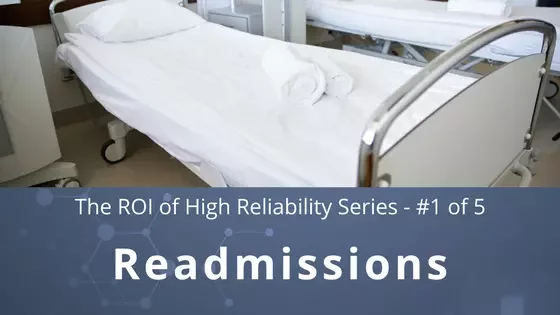
The 5 Key Metrics That Drive High Reliability
In this series, we explore 5 key metrics that both drive a hospital towards high reliability but will also give an ROI on process improvement initiatives beyond the initial financial investments.
Today, we look at readmission rates, and will continue the series based on: HAC scores, HCAHPS star ratings, Value Based Purchasing scores, and CMS star ratings.
1. Upgrade to a digital rounding solution
Use an enterprise-wide digital high reliability platform that collects quality observations and reap these benefits:
- Streamlined efforts to collect and aggregate data
- Real-time viewing of reports to determine the effectiveness of performance improvement projects
- Regulatory compliance automatically becomes a byproduct of proactive checking
- Improvement of processes drive high reliability
2. Measure patient experience
Hospitals seeking to improve patient satisfaction have begun tracking patient feedback in real time, improving their patients’ experience on the spot. As noted above, this kind of proactive patient rounding is best achieved in a digital real-time tool.
TIP: Measure more than just what is required in HCAHPS. Ask questions about room appearance, ease of understanding of bill, quality of the food, amenities (e.g., internet access), parking, timeliness of appointments, etc. There are plenty of ways to improve the patients’ experience, gain their trust, and improve your hospital’s reputation today!
3. Implement measures to lower HACs
- A process that ensures that key elements of care are consistent throughout the facility
- Systematic observation via digital rounding of actual nursing practices as well as infection prevention and control practices
- A robust tool to aggregate data so trends can be identified and addressed
- Strong performance improvement initiatives based on the data aggregation (Use a digital hospital rounding software that incorporates aggregation of data collected as well as personalized consulting to help guide the process.)
Ideally, these measures will include:
TIP: Once you’ve successfully completed a comprehensive HAC performance improvement initiative, don’t stop monitoring the issue. We’ve seen the most well-meaning PI teams fix issues and move on to the next. Without constant monitoring, the issues you worked hard to correct will eventually return. Continual process documentation and data analysis are your only insurance that a systemic issue stays corrected and sustains continuous improvement.
4. Invest in post-discharge calling
Multiple studies have shown that approximately 20% of patients have a post-discharge event and, of those events, nearly 30% are avoidable.
Post-discharge calling:
- Confirms patient understanding of discharge instructions
- Assesses patient transition from the hospital to the home setting
- Reinforces medication routines and reduce medication errors
- Sets or confirms follow-up appointments
- Improves perception of the patient care experience
Post-discharge calling works best when it is
- Digital
- In real-time
- Customizable
- Centralized
- Regularly reviewed
This is best implemented when using a solution that sends real-time issues to appropriate contacts. This type of follow-up process ensures that no issues fall through the cracks.
TIP: When using a digital solution for post-discharge follow-up calling, you not only benefit from a streamlined process and its built-in accountability, but the data can be analyzed to create proactive measures that help to eliminate future readmissions.
We will continue to explore the ways in which each of these metrics can offer return on investments in upcoming blog posts...
The Remaining Key Metrics That Drive High Reliability:
#2. Reducing HACs (read step 2 here)
#3. Increasing HCAHPs Ratings (read step 3 here)
#4. Improve Value Based Purchasing Scores (read step 4 here)
#5. Improve CMS Star Ratings (read step 5 here)
You can edit text on your website by double clicking on a text box on your website. Alternatively, when you select a text box a settings menu will appear. your website by double clicking on a text box on your website. Alternatively, when you select a text box.
